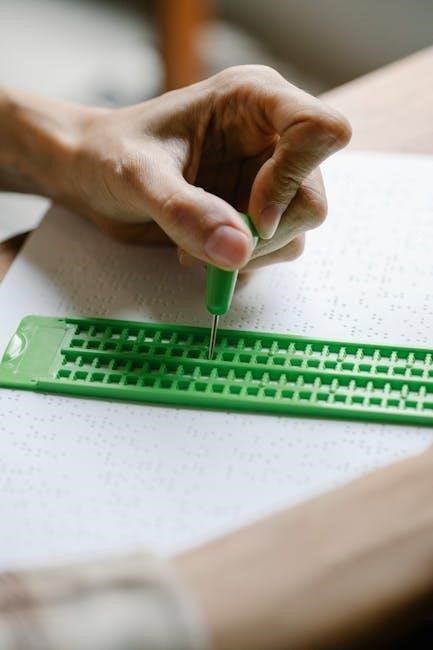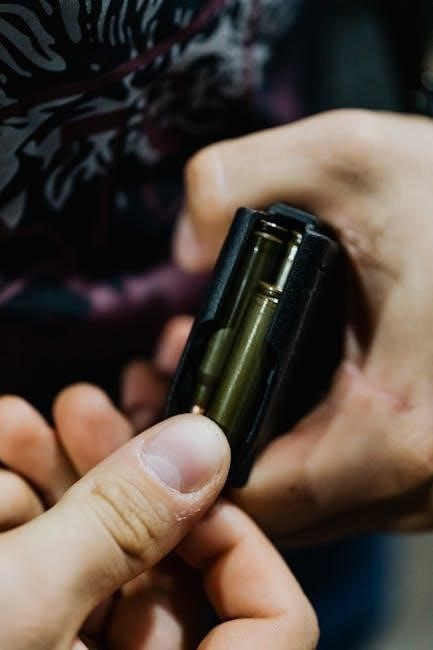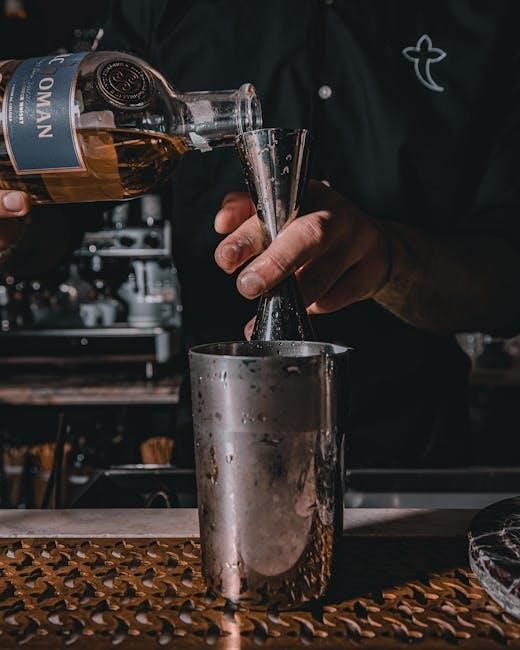Welcome to the Bartender Training Manual! This guide provides comprehensive insights into the art of bartending‚ covering essential skills‚ safety protocols‚ and customer service techniques. It serves as a roadmap for mastering the fundamentals and excelling in the role.
1.1 Purpose
The purpose of this Bartender Training Manual is to provide a comprehensive guide for aspiring and experienced bartenders‚ ensuring they possess the necessary skills‚ knowledge‚ and confidence to excel in their roles. This manual serves as a structured roadmap‚ covering essential topics such as drink preparation‚ safety protocols‚ customer service‚ and inventory management. By standardizing operational practices‚ it helps establishments maintain consistency and high-quality service. The manual is designed to onboard new bartenders effectively while offering advanced techniques for seasoned professionals to refine their craft. It emphasizes the importance of safety‚ sanitation‚ and efficiency‚ ensuring a positive experience for both staff and customers. Through detailed sections and practical insights‚ this guide aims to foster professionalism‚ creativity‚ and excellence in the bartending industry. Whether you’re starting your journey or seeking to enhance your expertise‚ this manual is an invaluable resource for achieving success behind the bar.
Key Sections of a Bartender Training Manual
This manual covers essential topics such as introduction to bartending‚ bar equipment‚ responsibilities‚ sanitation‚ and drink preparation. It provides a structured approach to mastering the skills and knowledge required for success in the bartending profession.
Bartending is an art that combines creativity‚ technical skills‚ and customer interaction. This section introduces the fundamentals‚ including the evolution of bartending‚ key roles‚ and basic techniques. It sets the foundation for understanding the profession‚ emphasizing the importance of product knowledge‚ teamwork‚ and adaptability. By exploring these elements‚ aspiring bartenders gain the confidence and skills needed to excel behind the bar‚ ensuring a memorable experience for every customer.
2.2 Bar Equipment and Tools
Familiarizing yourself with bar equipment and tools is essential for efficient and professional bartending. Primary tools include shakers‚ jiggers‚ muddlers‚ and strainers‚ which are used for mixing‚ measuring‚ and straining ingredients. Secondary tools like citrus juicers‚ blenders‚ and garnish cutters enhance drink preparation. Bar equipment such as coolers‚ ice bins‚ and glass racks ensure organization and accessibility. Understanding each tool’s purpose and proper usage is vital for creating high-quality drinks consistently. Regular maintenance of equipment ensures longevity and hygiene‚ while proper setup streamlines workflow. This section provides a detailed overview of the essential tools and equipment‚ helping bartenders master their use and integrate them seamlessly into their practice.
2.3 Essential Bartender Responsibilities
Bartenders are responsible for delivering exceptional customer experiences while maintaining operational efficiency. Key duties include preparing high-quality drinks‚ managing cash transactions‚ and ensuring a clean‚ safe environment. Bartenders must also monitor inventory‚ restock supplies‚ and maintain equipment. Effective communication with customers and team members is crucial for resolving issues and enhancing service. They are also tasked with upselling‚ suggesting specials‚ and handling customer preferences. Additionally‚ bartenders must adhere to health and safety protocols‚ prevent over-serving‚ and manage difficult situations professionally. Their role extends to maintaining the bar area’s organization and appearance‚ ensuring all tools and ingredients are accessible. By mastering these responsibilities‚ bartenders contribute to the success of the establishment and foster customer loyalty. This section outlines the core duties and expectations‚ providing a clear framework for bartenders to excel in their role.

Sanitation and Safety Protocols
This section emphasizes the importance of maintaining a clean and safe bar environment. It outlines cleaning schedules‚ proper handwashing techniques‚ and waste disposal methods to prevent contamination and foodborne illnesses. Additionally‚ it covers equipment sanitization and safety practices to ensure compliance with health regulations.
3.1 Cleaning and Sanitizing the Bar Area
Cleaning and sanitizing the bar area is a critical component of maintaining a safe and hygienic environment for both staff and customers. This process involves regularly disinfecting all surfaces‚ equipment‚ and tools to prevent the spread of bacteria and germs. The bar counter‚ sinks‚ taps‚ and storage areas should be cleaned thoroughly at the start and end of each shift‚ as well as during busy periods. Sanitizing solutions‚ such as bleach or alcohol-based cleaners‚ should be used to ensure effectiveness. Additionally‚ utensils and glassware must be washed and rinsed properly before being reused. A clean bar area not only adheres to health regulations but also enhances customer satisfaction and trust in the establishment. Proper waste disposal and recycling practices should also be implemented to maintain a tidy workspace. By following a consistent cleaning schedule‚ bartenders can ensure the bar remains a clean and safe space for everyone.
3.2 Safe Food Handling Practices
Safe food handling practices are essential for preventing foodborne illnesses and ensuring customer safety. Bartenders must adhere to proper hygiene standards‚ including washing hands frequently with soap and warm water‚ especially before handling food or ingredients. All food products‚ such as garnishes‚ mixers‚ and syrups‚ should be stored at appropriate temperatures to prevent spoilage. When preparing drinks‚ bartenders should use clean tools and utensils to avoid cross-contamination. Regularly inspecting ingredients for expiration dates and signs of spoilage is also crucial. Additionally‚ any food waste should be disposed of promptly to maintain a clean environment. By following these practices‚ bartenders can protect customers from potential health risks and uphold the reputation of the establishment. Proper training in food safety protocols is vital to ensure all staff members understand and implement these guidelines effectively. Consistent adherence to safe food handling practices creates a safe and reliable environment for both employees and patrons.
The Art of Drink Preparation
Mastery of drink preparation is the cornerstone of bartending. This section explores the techniques‚ ingredients‚ and creativity required to craft exceptional cocktails‚ from classic recipes to modern innovations‚ ensuring a memorable experience for every patron.
4.1 Basic Cocktail Recipes
Mastering basic cocktail recipes is the foundation of every successful bartender. These classic drinks form the backbone of any bar menu and are essential for building a strong skill set. From the timeless Old Fashioned to the refreshing Margarita‚ these recipes are timeless and universally loved. The Old Fashioned‚ made with bourbon or rye whiskey‚ sugar‚ and bitters‚ is a staple that showcases precision and balance. The Margarita‚ blending tequila‚ lime juice‚ and triple sec‚ is a vibrant and tangy crowd-pleaser. The Mojito‚ with its combination of rum‚ lime‚ mint‚ and soda water‚ offers a refreshing and herbaceous flavor profile. The Cosmopolitan‚ featuring vodka‚ triple sec‚ cranberry juice‚ and lime‚ is a modern classic that exudes elegance. Each recipe requires attention to measurement‚ technique‚ and ingredient quality. By perfecting these basics‚ bartenders can build confidence and creativity‚ eventually transitioning to more complex and innovative mixology; These foundational drinks are not only crowd favorites but also serve as a stepping stone to advanced bartending techniques.
4.2 Advanced Mixology Techniques
Advanced mixology techniques elevate bartending from a skill to an art form‚ allowing bartenders to create innovative and visually stunning cocktails; Molecular mixology‚ a modern approach‚ incorporates science to transform ingredients‚ such as spherification‚ foamification‚ and gelification‚ adding unique textures and presentation. Techniques like infusions and fat washing enable bartenders to infuse flavors into spirits‚ creating complex and intriguing profiles. Layering and floating are essential for crafting visually appealing drinks‚ while precision temperature control enhances flavor extraction. These methods require precision‚ creativity‚ and a deep understanding of flavor chemistry. Tools like sous vide machines‚ blowtorches‚ and siphons expand the possibilities‚ allowing for experimentation with unexpected ingredients. Mastering these techniques not only impresses customers but also sets a bartender apart‚ demonstrating expertise and innovation. Advanced mixology is about pushing boundaries while maintaining balance and harmony in every creation‚ ensuring each drink is a masterpiece of both taste and presentation.

Customer Service and Communication Skills
Exceptional customer service and strong communication skills are vital for bartenders to build rapport with patrons‚ handle feedback‚ and ensure a positive experience. These skills foster loyalty and enhance the bar’s reputation‚ making them indispensable in the industry.
5.1 Effective Communication Techniques
Mastering effective communication techniques is essential for bartenders to ensure seamless interactions with customers and colleagues. Active listening‚ maintaining eye contact‚ and using clear‚ friendly language are key components. These skills help in understanding customer preferences‚ managing orders accurately‚ and creating a welcoming atmosphere. Additionally‚ non-verbal cues like gestures and facial expressions play a significant role in conveying attentiveness and professionalism. Training manuals emphasize the importance of asking open-ended questions to gauge customer needs and preferences‚ ensuring personalized service. Effective communication also extends to handling difficult situations‚ such as resolving conflicts or addressing complaints‚ with patience and empathy. By honing these techniques‚ bartenders can enhance customer satisfaction‚ build loyalty‚ and maintain a positive work environment. Regular practice and feedback are recommended to refine these skills and adapt to diverse customer interactions.
5.2 Handling Difficult Customers
Handling difficult customers is an inevitable part of bartending‚ requiring patience‚ professionalism‚ and effective conflict resolution skills; Remaining calm and composed is crucial‚ even in challenging situations. Listening actively and empathizing with the customer’s concerns can de-escalate tensions. It’s important to avoid taking feedback personally and instead focus on finding solutions. Setting clear boundaries while maintaining a respectful tone ensures both parties feel heard. Offering alternatives or compromises can often resolve issues amicably. For example‚ if a customer is dissatisfied with a drink‚ politely asking how it can be adjusted demonstrates a commitment to satisfaction. If situations escalate‚ seeking support from a manager is a responsible step. Training manuals often emphasize the value of staying professional and maintaining a positive attitude‚ as these traits are essential for turning negative experiences into positive outcomes. By mastering these techniques‚ bartenders can minimize stress and create a more enjoyable environment for everyone involved.

Cash Handling and Point-of-Sale Systems
Accurate cash handling and efficient use of point-of-sale systems are critical for smooth bar operations. This section covers managing transactions‚ operating POS systems‚ and using technology to track sales and inventory effectively. Training manuals emphasize these skills to ensure precision and accountability.
6.1 Managing Transactions
Managing transactions efficiently is a cornerstone of bartending. This section outlines best practices for handling cash‚ credit card transactions‚ and tips. Bartenders must ensure accuracy in processing payments‚ handling change‚ and reconciling receipts. Proper handling of cash includes counting it accurately‚ storing it securely‚ and minimizing errors. Credit card transactions require attention to detail to prevent fraud and ensure customer trust. Additionally‚ managing tips involves fair distribution and reporting them for tax compliance. The section also covers how to handle split payments‚ discounts‚ and refunds seamlessly. Training manuals emphasize the importance of maintaining a balance between speed and accuracy during peak hours. By mastering these skills‚ bartenders can enhance customer satisfaction and contribute to the overall success of the establishment. Effective transaction management is critical for maintaining financial integrity and ensuring smooth bar operations.
6.2 Operating POS Systems
Mastering the Point-of-Sale (POS) system is essential for bartenders to streamline transactions and maintain efficiency. This section covers logging in‚ navigating the menu‚ and processing orders accurately. Bartenders learn to handle split payments‚ apply discounts‚ and issue refunds seamlessly. Understanding how to manage receipts‚ troubleshoot common issues‚ and perform end-of-shift reconciliation is also emphasized. The POS system integrates with inventory management‚ enabling real-time tracking of stock levels and minimizing waste. Training manuals highlight the importance of maintaining data security and adhering to privacy protocols when handling customer information. By mastering these skills‚ bartenders can enhance operational efficiency‚ reduce errors‚ and improve customer satisfaction. This section ensures bartenders are proficient in using POS systems to support smooth bar operations and maintain financial accuracy.

Inventory Management and Cost Control
Effective inventory management ensures accurate tracking of stock levels‚ preventing shortages or excess. This section covers strategies for minimizing waste‚ optimizing costs‚ and maintaining profitability through efficient resource allocation and financial planning.
7.1 Tracking Inventory
Tracking inventory is a critical component of effective bar management. It involves monitoring stock levels of spirits‚ beers‚ wines‚ mixers‚ and supplies to ensure availability and minimize waste. Regular audits and reconciliation of inventory help identify discrepancies and prevent theft. Utilizing tools like spreadsheets or POS systems can streamline the process‚ providing real-time data on product usage and reordering needs. Accurate tracking also aids in forecasting demand‚ ensuring that popular items are always stocked while avoiding overstocking of less popular products. This section outlines best practices for implementing an efficient inventory tracking system‚ including how to conduct audits‚ use technology‚ and maintain organization. By mastering these techniques‚ bartenders can contribute to cost efficiency and seamless bar operations. Effective inventory management is essential for maintaining profitability and delivering excellent customer service.
7.2 Reducing Waste and Optimizing Costs
Reducing waste and optimizing costs are essential for maintaining profitability in a bar operation. Bartenders play a key role in minimizing waste by accurately measuring ingredients‚ avoiding over-pouring‚ and using leftovers creatively. Regularly monitoring inventory levels helps prevent overstocking‚ which can lead to expired or spoiled products. Implementing precise pour measures and standardized recipes ensures consistency while reducing excess usage of ingredients. Additionally‚ training staff on efficient techniques‚ such as batching cocktails during off-peak hours‚ can further minimize waste. Optimizing costs involves negotiating with suppliers for better pricing‚ purchasing in bulk when feasible‚ and reducing energy consumption by maintaining equipment properly. By adopting these strategies‚ bars can significantly lower operational expenses while maintaining high-quality service. This section provides practical tips and strategies for bartenders to contribute to cost efficiency and sustainability in their establishment.

Advanced Bartending Techniques
Mastering advanced techniques like molecular mixology‚ precision pouring‚ and artistic garnishing elevates bartending to an art form. These skills enhance creativity‚ efficiency‚ and presentation‚ ensuring a memorable experience for customers and setting skilled bartenders apart.
8.1 Molecular Mixology
Molecular mixology is a cutting-edge approach that blends science with bartending‚ creating innovative and visually stunning cocktails. By using techniques like spherification‚ foamification‚ and gelification‚ bartenders can craft unique textures and flavors. This involves understanding ingredients at a molecular level and employing tools like sodium alginate and calcium chloride. The result is a sensory experience that intrigues and delights customers. Incorporating these methods requires precision and creativity‚ making molecular mixology a hallmark of modern bartending.
8.2 Garnishing and Presentation
Garnishing and presentation are essential skills for bartenders‚ as they elevate the visual appeal and overall experience of a cocktail. A well-crafted garnish can enhance the aroma‚ flavor‚ and aesthetic of a drink‚ making it Instagram-worthy and professionally presented. Common garnishes include citrus peels‚ olives‚ cherries‚ and fresh herbs like mint or rosemary. Each garnish should complement the cocktail’s ingredients and theme‚ adding a finishing touch that reflects the bartender’s creativity.
Mastering various techniques‚ such as twisting citrus peels for oils‚ slicing fruits neatly‚ or layering ingredients‚ ensures a polished look. Tools like zesters‚ knives‚ and garnish picks are indispensable for precise preparation. A well-garnished drink not only impresses customers but also showcases the bartender’s attention to detail and professionalism. This art form is a key element in modern mixology‚ transforming a simple drink into a memorable experience.
9.1 Summary of Key Takeaways
This manual has provided a comprehensive overview of the skills and knowledge required to excel as a bartender. From foundational bartending techniques to advanced mixology‚ the content is designed to equip you with the tools needed for success. Key areas covered include bar equipment‚ sanitation protocols‚ drink preparation‚ and customer service strategies. Emphasis was placed on the importance of safety‚ efficiency‚ and professionalism in a fast-paced environment. Additionally‚ the manual highlighted the evolution of bartending‚ from classic cocktails to modern molecular mixology‚ ensuring a well-rounded understanding of the craft. By mastering these concepts‚ you’ll be prepared to handle diverse scenarios‚ from managing transactions to creating exceptional customer experiences. Continuous learning and adaptability are encouraged to stay competitive in this dynamic field; This guide serves as a lasting resource‚ helping you grow from a novice to a skilled bartender.

